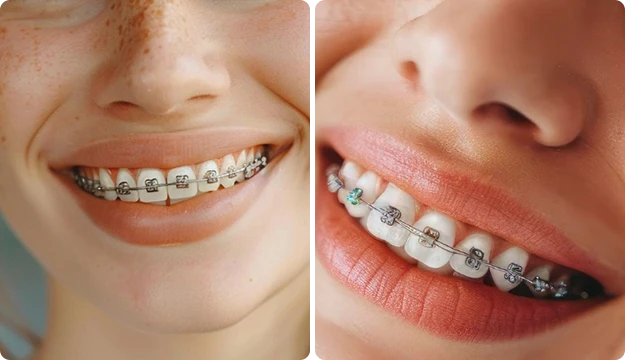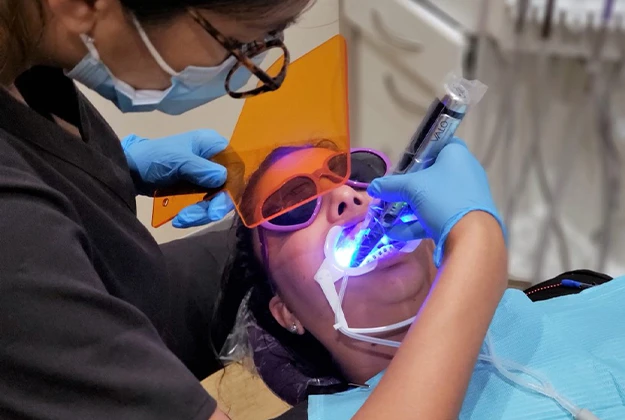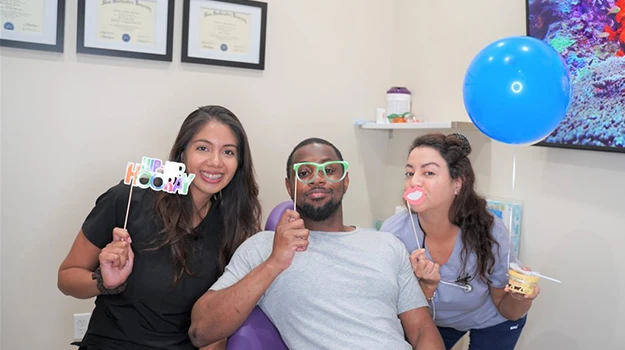HOW LONG DOES IT TAKE
TO GET BRACES ON?
HOW LONG DOES IT TAKE TO GET BRACES ON?
HOW ARE BRACES PUT ON
At an orthodontic office, it normally takes one hour to two hours to have the braces installed. Orthodontic records and paperwork may take additional time. Taking care of your dental health is more important to your overall health than you think. When it comes to keeping your teeth and jaw healthy, braces help a lot. Now comes the question of getting braces. While braces are intended for both adults and children to wear, there is still major misinformation on the subject.
HOW LONG DOES IT TAKE TO PUT BRACES ON
Getting braces for the first time can be a somewhat fearful experience. However, the truth is, braces are not half as bad or uncomfortable as you might think. Braces initially service various health-related purposes. Some of these include straightening the teeth and aligning the jaw. With that, braces also take care of other dental health issues, like overbite, underbite, teeth overcrowding, and dental-related migraines.
Braces are a standard procedure in fixing oral cavity deformities but are not the most beloved one. This is mainly due to a lack of information on braces and how they work. Braces are a standard procedure in fixing oral cavity deformities but are not the most beloved one. This is mainly due to a lack of information on braces and how they work.

HOW LONG DO BRACES TAKE TO WORK
The time requires to get your braces on takes a minimum of one to two hours. In one appointment or two, the process for putting them on could happen depending on your teeth and the kind of braces you’re going to wear.
HOW LONG DOES IT TAKE TO GET BRACES OFF
Now finally the answer to the question how long does it take to get braces off is between 1 year and a half to 6 years. This includes the period during which you wear your braces, the active period, and the period of stabilizing the work done. In general, if your case is not too complex, you will be dealing with your orthodontist for 2 to 4 years.
HOW LONG DOES IT TAKE TO GET APPROVED FOR BRACES
The real course of applying braces is extremely short, frequently the bottom teeth and the upper teeth are separated in various time blocks. It requires some time applying brackets to the base teeth because there’s regularly a considerable amount of saliva there, yet you are looking around 1 hour to 30 minutes for every column relying upon the teeth and the orthodontist. Your orthodontist will talk about treatment plans with you.
HOW DOES MY DENTIST KNOW I NEED TO GET BRACES
Crooked teeth, as well as jaw issues, are easy to spot by taking a standard dental exam. However, depending on the severity of your condition, your orthodontist or dentist may ask you to do an additional X-ray. With that, the dentist will know whether some teeth need extraction before your braces come on. Also, depending on your dental situation, your doctor might take a mold of your teeth, thus determining the greatest issue.

HOW LONG DOES IT TAKE FOR BRACES TO WORK
Usually, the process of getting braces does not take up more than one or two hours. Again, this all depends on your earlier dental diagnosis. If no greater issue arises, the orthodontic treatment will last the same for both children and adults. Initially, your dentist will begin by cleaning and drying your teeth. Next, come the brackets. In order to keep them firm on the teeth, your orthodontist will apply a bonding glue on your teeth.
Once the special glue hardens and the brackets are secured, it is time to place the wire. The wire usually goes over the brackets and is holding on to them alone. Keep in mind that braces can be used on the bottom jaw, upper jaw, or on both at the same time. Finally, your orthodontist might even recommend wearing elastic bands as well. These serve the purpose of expanding the jaw and making room for new teeth to settle. With this, braces put emphasis on your oral health and keep your oral well being in order. He or she also may add rubber bands to secure your braces.
HOW PAINFUL ARE BRACES TO PUT ON AND WEAR
Despite popular opinion in both adults and kids, braces are not painful to put on. Now, when it comes to wearing braces, there you might experience some discomfort or even suffer mouth sores. Still, this is all treatable and due to your teeth moving around in the jaw. Initially, putting on braces might cause an odd feeling in your cavity, but this has nothing to do with pain or compare to wisdom teeth pain.
At the same time, many patients reported a mild pain after having put on their braces. Still, this discomfort is not permanent. Even more, all initial symptoms of uneasiness in the mouth and teeth will fade away in a week. In some people, this sensation has been known to last for several months, due to a more problematic issue.

HOW TO PREVENT PAIN AFTER PUTTING BRACES ON
Here are a few simple and useful techniques to help you live a pain-free life with braces. Keep in mind all these remedies can be done at home:
- If you are feeling jaw or teeth pain, feel free to take an over the counter pain relievers. Painkillers usually help soothe the ache and help reduce the swelling as well.
- Make it your practice to apply Orajel or a related oral anesthetic. To get the best pain relief effect, apply the product directly over the gums.
- Make sure you are not chewing or biting food too harshly. As your braces near me already make you uncomfortable, hard food products may cause further irritation to the gums. Therefore, eating soft foods, like mashed potatoes, soup, and others, can help manage the pain better. In time, you will be able to return to your regular nutrition and eat anything you want.
- Do daily saltwater gargles. Salt water helps remove excess bacteria from the oral cavity and eases toothaches as well.
- Always use a soft toothbrush, easily found in nearby pharmacies and supermarkets. Don’t apply force when brushing your teeth and take your time, thus avoiding teeth and gums complications.
- Ask your dentist to give you an orthodontic wax for your teeth and gums, thus massaging the areas and relieving pain.
WILL I NEED TO ADJUST MY BRACES AFTER PUTTING THEM ON
To answer short, yes. As you know, the braces will have your teeth move inside the jaw. With this, your braces need to be additionally adjusted as well. The best way to do this is by making a dentist or orthodontist appointment and let them take over. Also, your dentist might make you different braces for you to wear until your braces come off. Commonly, the first adjusting braces appointment will happen in a month since putting your braces on. With this, your doctor can monitor your condition and make further estimations.
WHAT ELSE CAN YOU DO
An open conversation with your dentist is always advised, especially if you are wearing braces for the first time. Discuss all concerns and worries you might have, and trust your doctor to do your dental health justice. If you still feel uncomfortable by the idea of putting braces on, your dentist can give you a mild oral anesthetic to ease the process.
Finally, you can turn to ceramic braces, special types of braces colors which look, unlike the traditional braces. These often work better for working adults who prefer wearing more discreet braces, especially at work.

SUPPLEMENTAL CONTENT
Braces are so common with teenagers who have malocclusion due to crowded, crooked or gaping teeth. Regardless, braces are designed for everyone who has an orthodontic problem that can be treated with them.
WHAT IS THE PREPARATION PROCESS
When preparing yourself to start the process of getting braces, keep in mind that each orthodontic issue is different. So, the question of how long does it take to put braces can’t have a similar answer. If your orthodontist thinks that your problem is so complicated, then you can even take weeks before you get your set of braces. Besides, you might have to do up to three appointments prior to finally getting braces on your teeth. During the first appointment, your dental specialist might only brief you about the cost of braces, the period you might wear braces, the kinds of braces available other related information.
During the second visit, your orthodontist might take more time as they will need to examine your mouth, determine the most suitable appliances to offer you and take X-rays and teeth impressions and might give you spacers. The second session can take a few hours. The third session, which may happen after a week or more, will entail getting you ready for the actual process. In general, his process of getting braces will take one to two hours or less than one hour when getting clear teeth aligners. So, in truth, you might take two to three weeks to have braces placed on top of your teeth.
When the procedure is completed, you will be free to leave. Going back to work immediately might work if you pick the Invisalign, as its final session takes a shorter period of time plus the fact that it doesn’t cause unbearable discomfort. It is important to ask your orthodontist near me to demonstrate how you should be brushing and flossing with your fixed braces on. If you will select the Invisalign, it will be nice to know how to clean the aligners before putting them back on.
AMERICA'S TOP DENTIST
WHY SHOULD YOU BOTHER PUTTING BRACES ON
Numerous people who get braces want to improve their smile. While having a prettier smile is important, reducing and preventing long-term health issues is just as imperative. Moreover, crooked or crowded teeth are hard to clean and maintain and the obvious side effect is tooth loss, tooth decay or gum disease. It’s also imperative to note that poor teeth and/or jaw alignment can trigger unusual deterioration of teeth and affect chewing. Due to the stress caused by improper chewing, extreme stress can be put on the gum tissue and bone that is underneath your teeth. Hence, getting braces is the right way to get rid of malocclusion (bad bite) and its side effects. Once you decide to get braces, keep in mind that these will be the results:
- Straighter teeth and a prettier smile
- Healthier gums and teeth
- Aligned teeth and jaws
- Ability to maintain oral cleanliness on a daily basis
- Boost your self-esteem
Over a period of time, braces will apply just enough and consistent pressure on teeth via a sequence of wires and brackets. Gradually, teeth will move in a certain direction and as they move, the bone will change its form. After the removal of braces, usually within twelve to twenty-four months, your teeth will be straighter, jaws will be perfectly aligned and your smile will be excellent.
DOES THE PROCESS OF PLACING BRACES HURT
This is a question that every person likes to ask their dentist. When having your braces placed on teeth, you will not feel pain. However, getting used to the way the braces make your mouth feel can take a few days to weeks. It depends on the types of braces you will decide to wear. If you choose traditional metal braces, your mouth might feel sore for a longer time than if you go for the Invisalign system. As well as feeling sore, you might notice that your speech is slightly impaired when you get braces for the first time. This shouldn’t worry you because the problem will go away eventually. Having metal braces may mean feeling uncomfortable each time they are evaluated and adjusted by your orthodontist. But, if you choose the Invisalign, the only time you will feel a little discomfort is when you get the very first set of clear teeth aligners. By the time you get the next set, about 14 days after the first treatment, your mouth will have become accustomed to having them around. If you feel pain when wearing braces, try to eat soft food for the first 48 hours. These include soups, yogurt, scrambled eggs, cheese, milkshakes, mashed potatoes or pumpkins and so on. Your dentist can recommend over the counter pain killers to help control your discomfort and might as well provide an orthodontic wax to keep your mouth from developing pain sores in the next few weeks. Squeeze the wax between two fingers and press it on the metal brackets that are causing the pain. As well, it is imperative to avoid sucking on or touching your sores or teeth with the tip of your tongue or fingers. This is because these areas are so sensitive after the braces placement procedure.
As you get accustomed to wearing braces, you might notice that you are accidentally biting your inner cheeks and causing sores. Sometimes there isn’t much you can do about this problem and there is no need to worry because the sores will heal quickly. Painful areas can also be numbed using an OTC oral anesthetic drug like Orajel. Take a tiny piece of a cotton swab, dab a tiny amount of the anesthetic drug and apply it to your sores. Leave the gel to numb the area and eliminate your pain, enabling you to sleep at night. Due to the hardness of braces, your mouth might get some sores that can be healed via a weak solution of warm salt water that is used several times a day.
Finally, don’t consume an acidic diet, including citrus fruits, as this can irritate your mouth sores and cause a lot of pain. As soon as your mouth is able to adjust itself to braces, the discomfort will disappear. Most people are able to get accustomed to their braces in about a month, and earlier when wearing the Invisalign. After wearing traditional braces for about six months, it will be harder to notice that you even have them inside your mouth. One thing to keep in mind is that teeth that are being corrected via braces can start hurting for no clear reason. This is considered normal and should disappear rather quickly. If you cannot handle the pain, then you can take OTC pain killers.
FIVE-STAR PATIENT TESTIMONIALS

FREQUENTLY ASKED QUESTIONS

How Long Does It Take To Put On Braces?
The answer to this question depends on two things. First of all, do you have a well-educated and competent orthodontist? Second, what kinds of braces do you want to correct your orthodontic issue with? Needless to say, the process of installing new braces can get longer and exhausting if you are dealing with a less experienced orthodontist or someone who is not fully qualified. So, to ensure that the process of placing braces is shorter and accurate, you should select an orthodontic doctor who has the right education background and a lot of experience in their area. While general dentists can provide a braces treatment, they are not the right choice. It’s always right to deal with an orthodontist when you have a dental problem to do with misaligned teeth or jaws. It normally takes one hour to two hours to have your braces installed. Orthodontic records and paperwork may take additional time.
He or she is well-versed with all orthodontic appliances, techniques and current technology while a general dentist is not. Besides, dentists don’t have the additional two to three years of post-graduate training in orthodontics; they only have the first dental degree consisting of four years of study. Hence, as you search for the perfect dentist, make sure that you select an orthodontist. And to be completely sure that you are dealing with an orthodontist, ask to see their professional profile as well as contacts of some of their past customers.
If you pick the right professional, he or she will assist you to determine the best braces for your problem. After examining your teeth and jaws, your orthodontist will offer advice concerning the right types of braces. There are three kinds of braces you can get from dentists today and how long it would take to place them in your mouth would depend on the preferred kind. Firstly, your orthodontic problem may call for traditional metal braces. These have evolved in the fullness of time, explaining why they are now more comfortable than ever. Designed with a high-grade stainless steel material, metal braces make teeth straight via metal brackets and archwires.
Further, a patient can add colored elastics or rubber bands to ensure that their metal braces are looking different when they smile. Generally speaking, metal braces tend to be more uncomfortable than other teeth aligners and are harder to place in the mouth. Moreover, metal braces are worn for two years or longer depending on the severity of the orthodontic case.
The other type of braces that your orthodontist can select is the ceramic ones. These are made of clear, ceramic materials that look almost like your natural teeth. These tend to be more appreciated by older teenagers and adults as these are the people who are conscious about their appearances. Although these teeth aligners tend to be less visible, cleaning and maintaining them is a piece of work. They are brittle and bigger than metal braces, explaining why maintaining proper oral hygiene can be difficult. As well as this, ceramics are hardly suitable for straightening lower teeth.
They mostly suit front upper teeth. When it comes to the placement of metal and ceramic braces, a dental specialist will first clean and dry your teeth. Then, they will apply bonding glue directly to the teeth and attach the metal brackets or ceramic squares. While the bonding glue might taste bad, it is safe. Lastly, your orthodontist will place the wire that connects your teeth (archwire) in the brackets and tighten them with rubber bands. Generally, the task of placing metal or ceramic braces takes about one to two hours.
The third type of braces is called invisible or clear teeth aligners. These aligners tend to be so similar to the color of your natural teeth and are suitable for teenagers above 14 years and adults. Clear braces are the best choice when one cannot accept the idea of straightening teeth with metal braces. Currently, the most acceptable and renowned brand is the Invisalign System. It consists of plastic trays that are changed every two weeks. Each clear aligner is designed to move the tooth it is sitting on to a certain degree before it is swapped for a new one. It is important to wear your Invisalign braces for up to 22 hours each day. Thus, the Invisalign is removable and the most convenient kind of braces.
When you want to rest your gums and teeth, eat, drink or clean your mouth, simply remove your clear braces. Then attach them again so they can keep doing the type of work they were designed for. The Invisalign braces are also advantageous because they take just a small amount of time to fix when your aligners are delivered by Align Technology (the designer of the Invisalign System). Your orthodontist will be required to take your teeth impressions and send them by mail or deliver them digitally to Align Technology Inc. The company will take just a few days to come up with the right teeth aligners for your situation via software. As soon as your aligners are received, your orthodontist will be able to show you the final results on a computer screen. Generally, the task of placing Invisalign braces takes about one hour or less.








